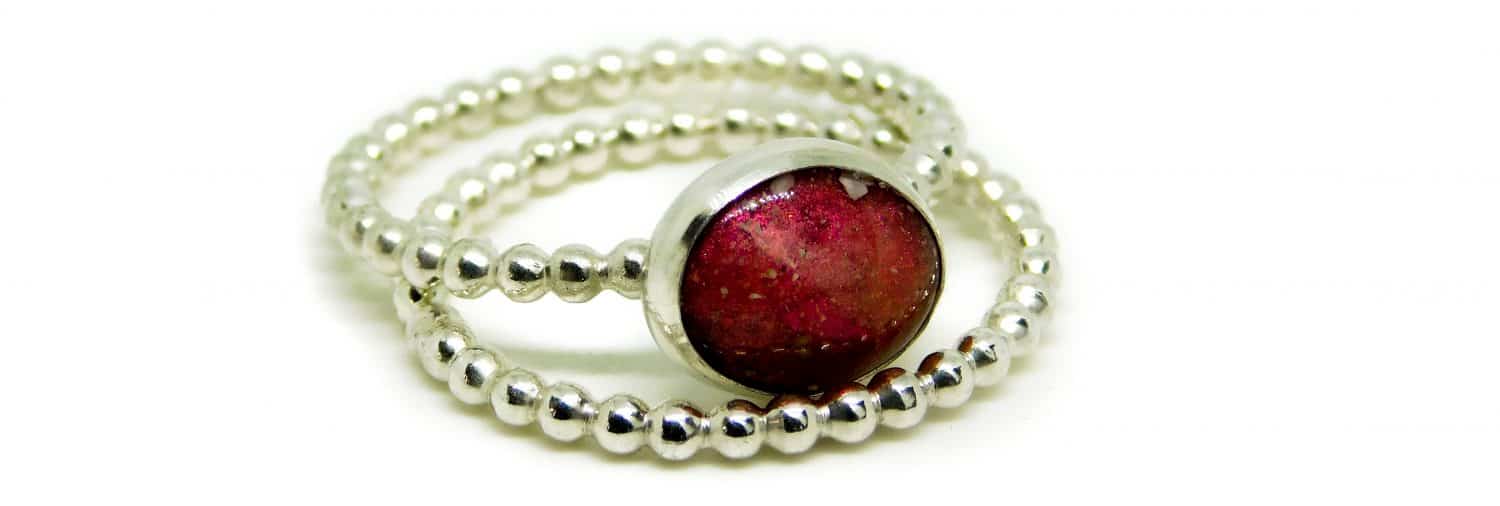This autumn I’m blogging about some of the questions on our FAQ’s which we’re often asked and one of the top questions is “why do you make extra cabochons?” The answer is, making keepsake and memorial jewellery is far more of an art than a production!
What Are Cabochons
Cabochons are the name for flat-backed “stones”, these can be made of anything from precious stones such as amethyst, to glass, resin, polymer clay or metal clay and many more. We work with UV resin, a kind of plastic that’s cured under UV light. We use silicone moulds to create a cabochon or “stone” with resin, your elements like ash and hair, colours and shimmers, birthstones and precious metal leaf. They’re cured under the UV lamp until hard and the edges are finished. We’re hoping to add glass cabochons soon which will be perfect for cremation ashes, you can read about the difference between glass and resin jewellery here.

Cabochons v Drip Method
When I first started creating keepsake and memorial rings I would buy settings such as these from Caverswall Minerals and these from ZDP Findings.
 Caverswall Minerals ring setting for resin
Caverswall Minerals ring setting for resin
They are mass-produced and are ideal for new artists who don’t have the skills to create their own ring settings, they don’t have lots of options and but they’re fairly inexpensive. Resin is dripped into the setting in layers with colours and elements such as ashes then finished with a clear coat of resin. The results are beautiful but I wasn’t able to make sure the client was happy with the colour before finishing the piece, and we started receiving complaints that the resin had fallen out from heartbroken clients. In 2015 I started to use moulds to make cabochons so that I could choose the best one and set it in the ring. The moulds were expensive and weren’t the right size for the ring settings from the suppliers, so I started making my own moulds using glass cabochons. Suddenly it opened me up to a much wider range of settings and I could give the client the choice before finishing the ring.
Why Do You Make Extra Cabochons?
First, we create a crystal-clear silicone cabochon mould out of a glass “master”, such as an oval or heart. The silicone comes from the USA and we sell the moulds on our sister site, Keepsaker Supplies (currently closed for maternity). Over on that site I’ve made a few blogs for other keepsake artists to help them, so you can read more about our methods there. We remove the bubbles from the silicone in a degassing chamber and they take a day or so to cure. The finished mould is then filled and the result is a cabochon or blank. We usually make at least two so that we can choose the best one to set into the client’s ring.

Whenever possible, we send a “proof photo” to the client, like this:

Why Do You Make Extra Cabochons? We ask if the client has a preference and we try to use that cabochon in the finished piece. Sometimes that’s not possible – we might find a flaw in the chosen cabochon or it might break during setting. We have to use a bit of artistic licence with every piece; for more info see section 3.7 of our Terms and Conditions and don’t forget that every piece is as unique as the lock of hair or ash grains, the artists making the cabochons and the metalsmith setting the piece. The colours and birthstone we add are usually similar but we get huge variation from the elements themselves. One piece made by the same artist with the same ash and colour will look totally different if made again five minutes later and we never guarantee results. All we can do is try our best and hope that you love your jewellery like so many of our other clients.


One thought on “Why Do You Make Extra Cabochons?”